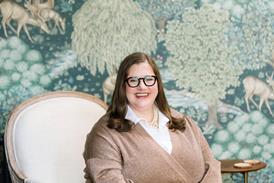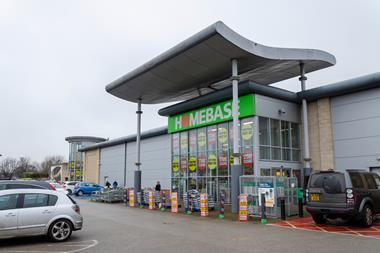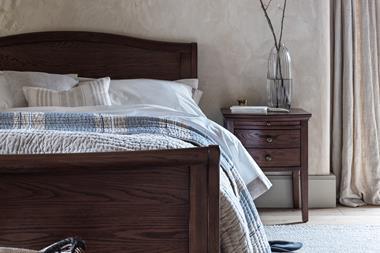By 2020, more than half the population will be over 50, which makes marketing to the grey pound a golden opportunity. Liz Morrell looks at how retailers are catering for this lucrative sector
Seventy-two-year-old Pauline Button has just shown me the latest additions to her summer wardrobe - three tops she picked up in Esprit. This comes only a few months after the Victorian-style blouse she bought from New Look when they were in style last season - not the typical 72-year-old’s favourite shop.
Joyce Adlington, a sprightly 91-year-old, is also proud of her latest purchases - a top and skirt from Marks & Spencer that she must now somehow cram into her wardrobe, which is already straining at the seams. For a woman who spent years working in fashion retail she is, by her own admission, still a shopaholic. ‘Do I love shopping? You can say that again!’ she laughs.
Pauline and Joyce are part of the growing number of customers who still love fashion, shopping and picking up a good-quality bargain, despite the fact it may be a while since they started collecting their pensions. Their shopping habits are also increasingly reflecting older customers’ young-at-heart attitudes.
‘When I was younger, you went more for things for your age. Now people have got younger in their minds and are wearing younger things,’ says Mrs Adlington.
This attitude shift is crucial for retailers when trying to cater for the older market and is something many can get wrong.
Fiona Hought, managing director of Millennium, a marketing agency which specialises in the over-50s market, says a common mistake made by retailers and marketers is to lump everyone over the age of 50 into one lookalike group. Instead, her company splits the group into four categories:
1) Thrivers - aged 50 to 59 (7.5 million last year)
2) Seniors - aged 60 to 69 (5.59 million last year)
3) Elders - aged 70 to 79 (4.3 million last year)
4) Survivors - aged 80-plus (2.57 million last year)
The figures show the over-50s market is massive. In 1901, there were just 5 million over-50s. Within the next 20 years, there will be about 25 million. Over-50s account for more than a third of the UK population and have a spending power of£205 billion a year - accounting for 40 per cent of total spending power and 80 per cent of the nation’s wealth.
But the market is set to get bigger still. With 50,000 people turning 50 each month, they are the only growth market. By 2020, more than half the UK population will be over 50 - a rise of 30 per cent - while under-50s will decline by 5 per cent, according to figures from Millennium.
A spokesman for Help the Aged says: ‘Older people as a group of consumers are gathering strength, with many believing that the existing 45- to 59-year-old generation potentially represents a golden generation - being much better off than their predecessors.’
This age group, whose children have left home and whose mortgages are paid off, also has more disposable income than their younger counterparts -£13,673 for post-family households, compared with£8,603 for family households and£10,280 for pre-family households, according to figures from Datamonitor.
Millennium says those over 50 in employment outspend under-50s by more than 20 per cent. Importantly, these customers are also the most time-rich. ‘They’re more likely to have the time and money to indulge their whims,’ says Hought. This could be increased spending on leisure activities, such as travel and gardening, or other indulgences as they spoil themselves after years of hard work.
According to Mark Tesseyman, brand director of clothing chain Bonmarche, which specialises in the 45-plus market, this time element is where retailers can win with older customers. Providing them with the customer service element they need because of their age, or want because of their increased time, means that they will respond well to retailers that make small investments in their service propositions. ‘Our customers love to be talked to and love the service element, because they are time-rich,’ he says.
Mrs Adlington is a fan of high street chain Edinburgh Woollen Mill because of the service. ‘They exchange more willingly, for instance if you haven’t been able to try it on and go out of their way to help. Customer service is very important,’ she says.
EWM chief executive Philip Day is pleased to hear her comments. ‘We have always tried to have a nice, warm, friendly environment where the customer genuinely is always king,’ he says. ‘It’s about good old-fashioned manners - nothing more sophisticated than that,’ he says.
While older customers are after value, they have a keen eye for quality. ‘I like it to be reasonable, but it must be good quality so that it will last a while,’ says Mrs Adlington.
‘Our customer is looking for something that is fashionable but very practical and built to last, that will give them performance as well as giving them a look,’ Day says.
A knowledge of the fabric used and an appreciation of how the garment will be used is vital. ‘The older customer doesn’t want to be stood next to an ironing board all the time,’ says Day.
EWM’s traditional focus has been on the over 60s market but it is increasingly targeting the younger 40 plus market too. ‘We have got the new granny who is 55 years old but feels 40 so you must bring in collections that will offer the fashion she wants but still gives her the performance too,’ he says.
Bonmarche has also realised there is more than one type of older consumer ‘The big thing at the moment is people’s attitudes,’ says Tesseyman. ‘For instance, although Paul McCartney has just turned 64, he acts more like 54 or 50. We have more than 3 million people on our database and their average age is 61, but by attitude they are about 10 years younger.’
This makes meeting their needs as different as those of teenager and adult. ‘They don’t want the stuff their mums wore or are wearing, so we have to be very careful to offer product that’s acceptable to the 65-year-old and the 80-year-old who wants pleated skirts,’ he says.
As a result, the retailer is offering more fashion-led product in terms of colours and styling, alongside its more traditional basics. ‘What differs is the fit. You have to be sympathetic, but don’t make it look old fashioned. It’s fashionability with a small ‘f’,’ he says.
Retailers operating in the clothing market for such a customer are at an advantage too - being able to tweak looks rather than completely overhaul them the following season. ‘They will be looking for it again,’ says Day.
Frumpy for the over-50s is out, because retailers have to remember that, as the 1960s generation hits old age, this is the most accepting and free-spirited customer there has ever been, and they want that reflected in the products they are buying. ‘We are finding older customers are shopping for and buying brighter colours - after all, the 1960s was the most liberated age of all,’ says Tesseyman.
However, it is a delicate balancing act. Marks & Spencer is probably the starkest illustration of how aiming too young can alienate a very large and important market. Its attempt to focus on a younger customer drove away its classic older customers a few years ago.
Today, the retailer has won those customers back - with new products and clever marketing. ‘I love M&S because they have always got my size and a large variety to choose from and it fits in with loads of age groups,’ says Mrs Adlington. ‘They have got much better,’ she says. ‘There is always someone to help and there are plenty of fitting rooms, including disabled, even on busy days.’
M&S’s recent success in winning customers back is partly thanks to not strictly defining age in its stores. Retailers that are successful in the older market agree segmentation by age is not the answer - particularly when marketing to them. ‘We talk about inclusive advertising,’ says Hought. ‘For example, the Twiggy M&S advertising campaign was successful because it was inclusive and everyone identified with it. People don’t want to broadcast an overtly mature message,’ she says.
Tesseyman agrees. ‘You can’t treat them as old,’ he says. ‘We put less emphasis on age because people don’t want to talk about age.’
To really empathise with the older market, retailers must understand the mindset and needs of older shoppers and the everyday challenges that their age may or may not present, says Hought. The challenge is delivering solutions to these special touches subtly, without making the customer feel they are being treated differently.
Earlier this year, Hought’s agency worked with Tesco designers, who were given retinal degenerative glasses, latex gloves to simulate arthritis and earplugs to impair hearing. ‘Retailers must try to understand some of the concerns,’ he says.
Operationally, retailers must be aware of the needs of older shoppers, such as providing seating and easier access, perhaps for electronic chairs.
Following research into the older consumer’s use of retail, Help the Aged policy manager David Sinclair says this sort of thing is a common complaint. ‘One of the things people are saying is that in the old days there used to be seats by the tills - there aren’t anymore so that plays, or can play, a part in them not going to the store,’ he says.
Tesseyman says: ‘With spacing of stores we are very sympathetic and we also offer chairs at the front of the stores - although these tend to be used by abandoned husbands,’ he says.
Hought says retailers can do more. ‘If you look at particular sectors of retail - for instance, supermarkets - there are some things they do well and some they don’t. For example, they have lots of parking bays for disabled and mother-and-baby shoppers, but none for pensioners. Store layouts can also be confusing and there is nowhere for older customers to sit down because shops are designed for maximum sales space,’ she says.
Packaging and product placement can also be a stumbling block for older customers. Products can be hard to reach because the shelves are either too high or too low to be accessible to the less mobile and packaging can sometimes be hard to open or difficult to read.
The weight of product is also important. ‘It’s about whether you can buy appropriate product - for instance, the move to selling in bulk makes it difficult for old people living alone,’ says Sinclair.
Discriminating by age will lose retailers business. Age discrimination employment law, which comes into effect later this year, is forcing the issue up the agenda, but Sinclair says Help the Aged is also lobbying the Government to include a ban on age discrimination with regard to access to goods, facilities and services. This would force retailers to make operational changes to better meet the needs of older customers.
But this isn’t just about complying with possible changes to the law - it is about winning new business from a lucrative sector of the market. Retailers need to look hard at how they target the older market if they want to take full advantage of the grey pound - whether they are looking at product, marketing or store operations. ‘There are a range of things older people feel retailers could do better,’ says Hought. ‘It’s not necessarily stopping them spending money, but if they were to engage better with them they may spend more,’ she says.
CACI head of property consulting Ken Gunn agrees. ‘The whole marketing industry really ignores this group, but they can’t afford to over the next 10 to 20 years,’ he says.
Any retailer that fails to act could be missing out on a golden opportunity. ‘Its important to tap into this as a market, because it’s here, then it will be gone and it won’t be seen again,’ warns Hought.
OLDER AND WISER
What do older customers really think of the shopping experience retailers offer them? Meet avid shoppers the Hewetts
When Marks & Spencer developed its flagship store at Cardinal Place in London’s Victoria, it probably hadn’t anticipated how its cappuccino bar would become the centre of the community for local old people.
Among the regulars are Mr and Mrs Hewett, a couple of sprightly 80-somethings who are avid shoppers and love their new local M&S store.
‘We see everyone in here,’ Mrs Hewett laughs. ‘All the old people come in here in the morning, then go home at lunchtime. A lot of them come back in for the afternoon.’
Older people tend to go shopping more than most. ‘It’s more or less somewhere to go for us,’ says Mrs Hewett, who adds that they go shopping three or four times a week. As a result, they are acute observers of the retail scene.
‘A few years ago, Marks & Spencer used to ignore their older customers. They had all these dresses for the young ones, but none of them ever went in. It’s much better now. And the clothes are much cheaper than they were,’ she says.
But while M&S is seen as wanting to attract older customers, it is one of only a very small number of stores that older people feel actively welcome them.
‘Marks & Spencer and Bhs are the only shops I can go in for clothes, now that Littlewoods and C&A are gone,’ says Mrs Hewett. ‘All the other shops are for youngsters - I’d never go in Next, I wouldn’t feel welcome.’
The standard of customer service is particularly important to older customers and the Hewetts have experienced both the best and the worst sides of big retailers.
Many retailers go beyond the call of duty. Earlierthis year, the Hewetts attempted to buy a cabinet from their local Argos store. Having expected to be able to order it for home delivery they were told it was out of stock at the warehouse, but in stock at the store. When they found it was too heavy to carry home, the store manager offered to walkthe 30 minutes back with the Hewetts, pushing it on a trolley.
They also praised Marks & Spencer in Oxford Street, where staff haveregularly helped one of Mrs Hewett’s friends with stairs and allowed her to wait in a staff area while they called her a taxi home.
However, their experiences are mixed and supermarket trips represent a particular challenge. ‘Not many of them go out of their way to help. Sometimes in Sainsbury’s they say ‘do you want any help packing?’, they’re good, but no one else does,’ says Mrs Hewett.
Tesco comes bottom place for the Hewetts. A few months ago, Mr Hewett complained he was given change out of£10 instead of£20. When the couple complained, they felt patronised by Tesco’s response. Eventually they were sent a gift card as compensation, supposedly loaded with£20, but when they tried to use it, it emerged the card had no credit on it.
However, the couple believe retail has improved down the years generally - there is no sentimentality about the shops of the past. ‘It used to be all smaller shops round here, like Cullens, but they’ve all gone. It’s much better now - people used to have to go to markets because everything in the shops was so dear,’ says Mrs Hewett.



























No comments yet